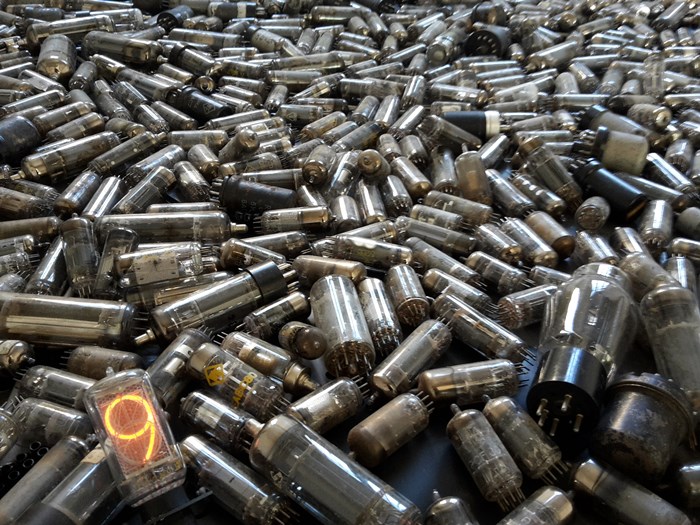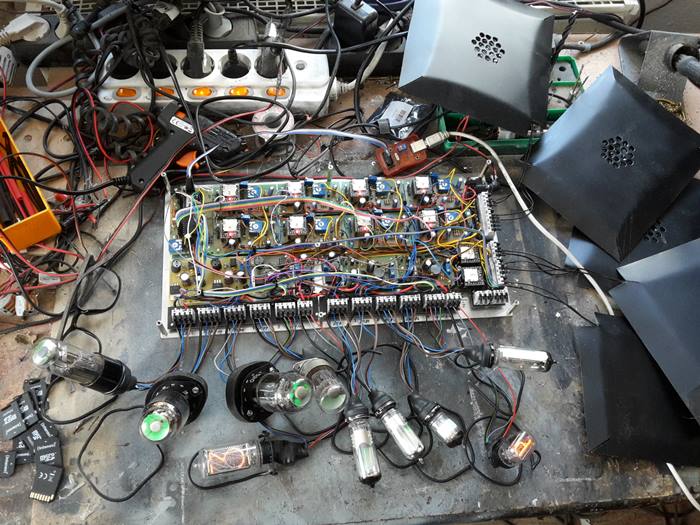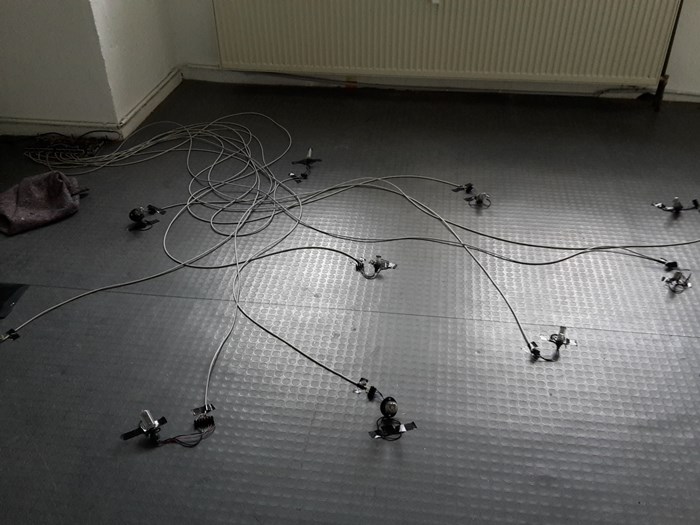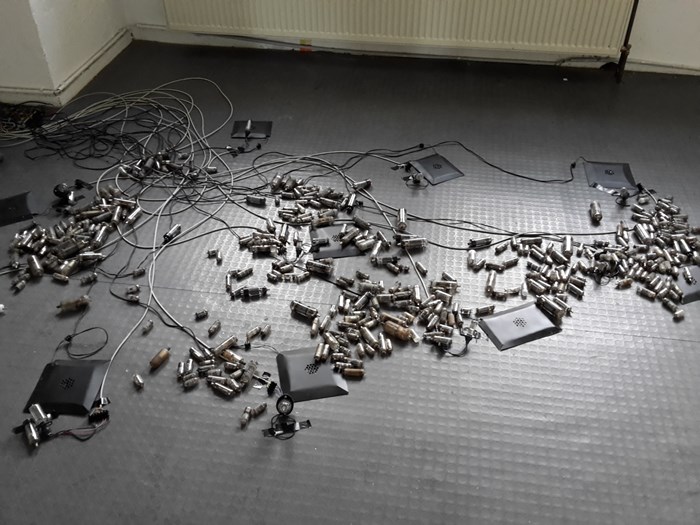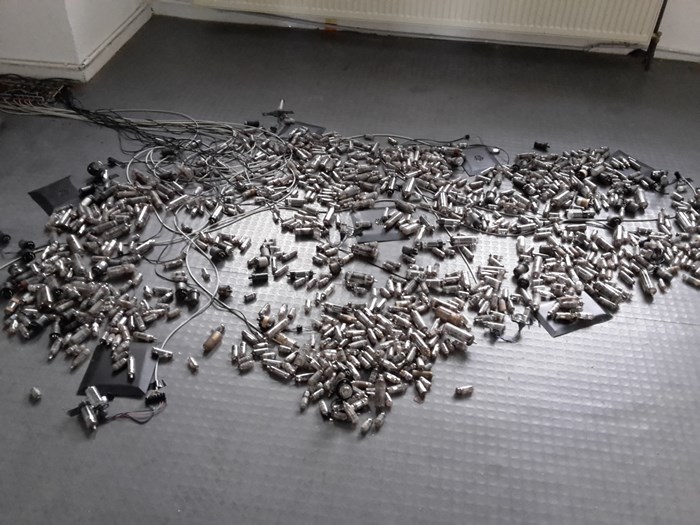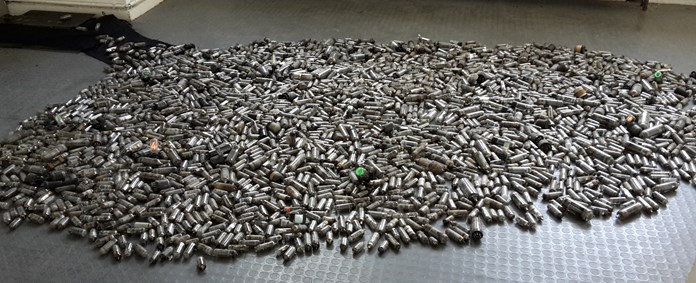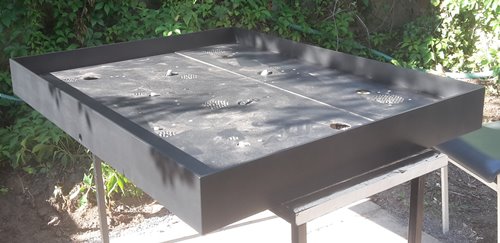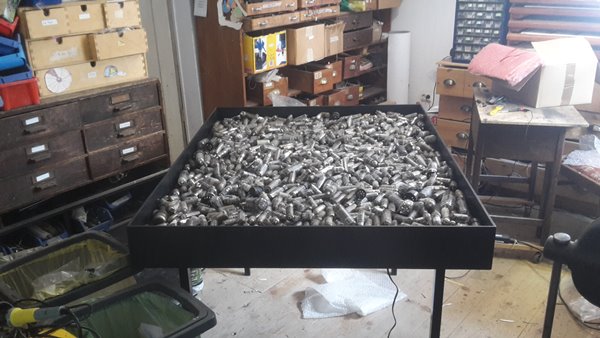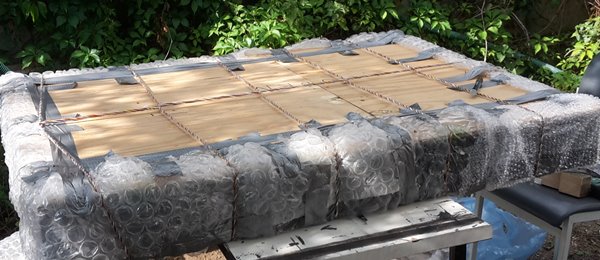UA 2019 - Braunschweig - Allgemeiner Konsumverein
zur Tischvariante
Mehr als 2000 Radio- und Fernsehröhren aus den 1930er bis 1960er Jahren. Einige funktionieren noch.
Versteckte Lautsprecher lassen Klänge und Geräusche erklingen und verändern die grünen Felder der magischen Augen bzw. die Ziffern der Nixieröhren.
Die Komposition ist mehrkanalig und vermittelt so den Eindruck einer musikalischen Konversation zwischen den "noch lebenden" Röhren.
To the table version
More than 2000 radio and television tubes from the 1930s to the 1960s. Some still work.
Sounds and noises come from hidden loudspeakers. These influence the green fields of the magic eyes and the digits of the nixie tubes.
The composition is multi-channel and thus conveys the impression of a musical conversation between the "still alive" tubes.
Unmengen von Radio- und Fernsehröhren liegen dicht beieinander - die Röhren sind "tot" - die filigranen Glaskolben haben aber auch eine
besondere Ästhetik - sie sind zerbrechlich und empfindlich - zwischen den "toten" Röhren sind einige, die noch funktionieren - es hat den Anschein, dass
es die letzten "überlebenden" sind, die noch arbeiten und nach einem bestimmten Prinzip miteinander kommunizieren - seltsame akustische Zeichen werden
nach einem scheinbar durchdachten Algorithmus ausgetauscht - eine vergangene Art erfreut sich ihrer letzten Atemzüge.
In meinen Röhreninstallationen wird alte mit neuster Technik gekoppelt. Ein Minicomputer wie der Raspberri PI steuert Mikrorechner. Die Röhrentechnik
nutzt eine Spannung von 250V. Das magische Auge im Besonderen hatte damals seine Faszination in Radios und Tonbandgeräten. Es war für deren Funktion
nicht unbedingt notwendig, sondern "nur" ein schätzenswertes Accessoire.
Die Installation soll u.a. zeigen, dass alle neuen Bauelemente, die unsere technische Entwicklung gravierend beeinflussen, einmal alt werden
und im Müll landen. Jedes Mal aber bauen wir eine ganze Industrie dafür auf bzw. um und nutzen Massen an Rohstoffen, um uns der Faszination
der Elektronik, der ich natürlich auch erlegen bin, hinzugeben. Zählt das zu den Eigenschaften der Menschen? Ich vermute ja. Gibt es nicht irgendwann ein mal
das unendlich haltende in der Entwicklung abgeschlossene technische Gerät? Ich vermute nein.
Verwendung der Fotos frei bei Angabe des Fotografen ! ES = Erwin Stache
Huge numbers of radio and television tubes lie close together. The tubes are "dead". The filigree glass bulbs have a special aesthetic. They are fragile and
sensitive. Among the "dead" tubes are some that still work. It seems that they are the last "survivors". They communicate with each other according
to a certain principle. Strange acoustic signs will be exchanged according to an apparently well thought-out algorithm. A bygone species enjoys its last breaths.
In my tube installations, old technology is coupled with the newest. A minicomputer like the Raspberri PI controls microcomputers. The tube technology uses a
voltage of 250V. The magic eye has fascinated in the old radios and tape recorders. It was for their function not absolutely necessary, but "only" a
valuable accessory.
The installation is intended to show that all new components that have a serious impact on our technical development become old and end up in
the trash. But every time we build or convert an entire industry for it and use masses of raw materials. All because of the fascination of the electronics, which of
course I also succumbed to. Is that one of the characteristics of human beings? I assume so. Isn't there sometime the indefinitely lasting technical device
completed in development? I suspect no.
The photos can be used freely if the photographer is named! ES = Erwin Stache

